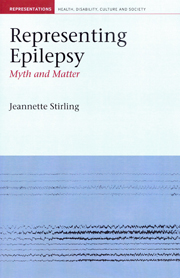Book contents
- Frontmatter
- Contents
- Acknowledgements
- Introduction
- 1 From Hippocrates to Shakespeare and Dickens: epilepsy's entry into ‘the circuit of culture’
- 2 Hystericity and hauntings: the female and the feminised
- 3 Notes from the borderlands: repressing the returned
- 4 The colonies
- 5 Because you're ‘you know. That way’
- Where to next? The ongoing story of epilepsy
- Bibliography
- Index
2 - Hystericity and hauntings: the female and the feminised
- Frontmatter
- Contents
- Acknowledgements
- Introduction
- 1 From Hippocrates to Shakespeare and Dickens: epilepsy's entry into ‘the circuit of culture’
- 2 Hystericity and hauntings: the female and the feminised
- 3 Notes from the borderlands: repressing the returned
- 4 The colonies
- 5 Because you're ‘you know. That way’
- Where to next? The ongoing story of epilepsy
- Bibliography
- Index
Summary
Life is short, science is long; opportunity is elusive, experiment is dangerous, judgement is difficult. It is not enough for the physician to do what is necessary, but the patient and the attendants must do their part as well and circumstances must be favourable.
(Hippocratic aphorism, 400 BCE)The Hippocratic physicians insisted that epilepsy was a physical disease rather than a metaphysical mutation. This way of thinking about the disorder circulated beyond Cos and into a new millennium: Galen developed his theories about the disorder from similar principles. Nevertheless, fear that epilepsy signified spiritual contagion from possession was to play a part in discriminatory and stigmatising processes in biblical narratives. That fear reappeared in the political propaganda circulated in early seventeenth-century debates about witchcraft, religious faith and knowledge boundaries. By the eighteenth century, the notion that epilepsy was contagious had been more or less refuted, only to be replaced by a widely held conviction that exposure to the convulsing body could excite disorder in the sensitive and vulnerable bystander and the sight of a grand mal seizure was enough to contaminate the foetus of a pregnant woman.
To a significant extent, and despite some progress in modernising medical models of epilepsy, this stream of beliefs continued to hold some sway over medical thinking through the latter decades of the nineteenth century and into the twentieth.
- Type
- Chapter
- Information
- Representing EpilepsyMyth and Matter, pp. 36 - 80Publisher: Liverpool University PressPrint publication year: 2010



